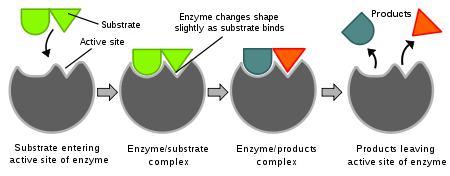
Active site
Encyclopedia
In biology the active site is part of an enzyme
where substrates bind and undergo a chemical reaction
. The majority of enzymes are proteins but RNA enzymes called ribozymes also exist. The active site of an enzyme is usually found in a cleft or pocket that is lined by amino acid
residues (or nucleotides in ribozymes) that participate in recognition of the substrate. Residues that directly participate in the catalytic reaction mechanism are called active site residues.

The induced fit model is a development of the lock-and-key model and instead assumes that an active site is more flexible and that the presence of certain residues (amino acids) in the active site will encourage the enzyme to locate the correct substrate, after which conformational changes may occur as the substrate is bound.
In other words, the active site modifies the reaction mechanism in order to change the activation energy of the reaction. The product is usually unstable in the active site due to steric hindrances that force it to be released and return the enzyme to its initial unbound state.
Enzyme
Enzymes are proteins that catalyze chemical reactions. In enzymatic reactions, the molecules at the beginning of the process, called substrates, are converted into different molecules, called products. Almost all chemical reactions in a biological cell need enzymes in order to occur at rates...
where substrates bind and undergo a chemical reaction
Chemical reaction
A chemical reaction is a process that leads to the transformation of one set of chemical substances to another. Chemical reactions can be either spontaneous, requiring no input of energy, or non-spontaneous, typically following the input of some type of energy, such as heat, light or electricity...
. The majority of enzymes are proteins but RNA enzymes called ribozymes also exist. The active site of an enzyme is usually found in a cleft or pocket that is lined by amino acid
Amino acid
Amino acids are molecules containing an amine group, a carboxylic acid group and a side-chain that varies between different amino acids. The key elements of an amino acid are carbon, hydrogen, oxygen, and nitrogen...
residues (or nucleotides in ribozymes) that participate in recognition of the substrate. Residues that directly participate in the catalytic reaction mechanism are called active site residues.

Binding mechanism
There are two proposed models of how enzymes work: the lock and key model and the induced fit model. The lock and key model assumes that the active site is a perfect fit for a specific substrate and that once the substrate binds to the enzyme no further modification is necessary; this is simplistic.The induced fit model is a development of the lock-and-key model and instead assumes that an active site is more flexible and that the presence of certain residues (amino acids) in the active site will encourage the enzyme to locate the correct substrate, after which conformational changes may occur as the substrate is bound.
Chemistry
Substrates bind to the active site of the enzyme or a specificity pocket through hydrogen bonds, hydrophobic interactions, temporary covalent interactions (van der Waals) or a combination of all of these to form the enzyme-substrate complex. Residues of the active site will act as donors or acceptors of protons or other groups on the substrate to facilitate the reaction.In other words, the active site modifies the reaction mechanism in order to change the activation energy of the reaction. The product is usually unstable in the active site due to steric hindrances that force it to be released and return the enzyme to its initial unbound state.
See also
- Enzyme catalysisEnzyme catalysisEnzyme catalysis is the catalysis of chemical reactions by specialized proteins known as enzymes. Catalysis of biochemical reactions in the cell is vital due to the very low reaction rates of the uncatalysed reactions....
- Hugh Stott TaylorHugh Stott TaylorHugh Stott Taylor was an English chemist primarily interested in catalysis. In 1928, in a landmark contribution to catalytic theory, Taylor suggested that a catalyzed chemical reaction is not catalyzed over the entire solid surface of the catalyst but only at certain ‘active sites’ or centers.He...
- Catalytic triadCatalytic triadA catalytic triad refers to the three amino acid residues found inside the active site of certain protease enzymes: serine , aspartate , and histidine . They work together to break peptide bonds on polypeptides. In general terms, catalytic triad can refer to any set of three residues that function...
- Activity based proteomicsActivity based proteomicsActivity based proteomics, or activity based protein profiling is a functional proteomic technology that uses specially designed chemical probes that react with mechanistically-related classes of enzymes. The basic unit of ABPP is the probe which typically consists of two elements: a reactive...
External links
- Catalytic Site Atlas (CSA) — hosted by EMBLEuropean Molecular Biology LaboratoryThe European Molecular Biology Laboratory is a molecular biology research institution supported by 20 European countries and Australia as associate member state. EMBL was created in 1974 and is an intergovernmental organisation funded by public research money from its member states...
-EBIEuropean Bioinformatics InstituteThe European Bioinformatics Institute is a centre for research and services in bioinformatics, and is part of European Molecular Biology Laboratory...

